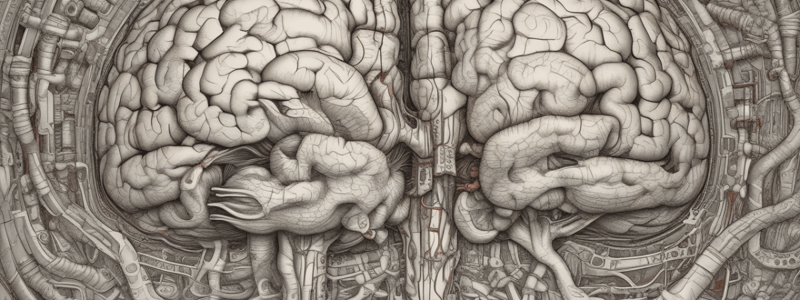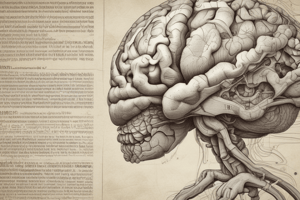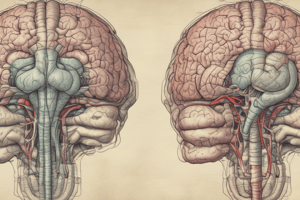Podcast
Questions and Answers
Which areas, beyond the gyri, are associated with gray matter in the cerebrum?
Which areas, beyond the gyri, are associated with gray matter in the cerebrum?
- Cortex only
- Basal nuclei only
- Both the cortex and basal nuclei (correct)
- Only white matter
What is a function of the basal nuclei?
What is a function of the basal nuclei?
- Control the endocrine system
- Regulate memory processing
- Initiate and terminate movements (correct)
- Coordinate sensory signals
What is the basal nuclei's role in muscle tone?
What is the basal nuclei's role in muscle tone?
- Enhance muscle contraction
- Suppress muscle tone
- Regulate muscle tone (correct)
- None of the above
How many basal nuclei help in movement regulation?
How many basal nuclei help in movement regulation?
Which diseases are associated with the basal nuclei?
Which diseases are associated with the basal nuclei?
What are the main types of neurons found in the cortex that release glutamate?
What are the main types of neurons found in the cortex that release glutamate?
Which neurotransmitter is generally released by interneurons, causing inhibition?
Which neurotransmitter is generally released by interneurons, causing inhibition?
Which part of the brain shrinks severely in Alzheimer's disease?
Which part of the brain shrinks severely in Alzheimer's disease?
What is the limbic system often referred to as?
What is the limbic system often referred to as?
What happens to the cerebral cortex in Alzheimer's disease?
What happens to the cerebral cortex in Alzheimer's disease?
Which part of a neuron in the cortex forms multiple branches?
Which part of a neuron in the cortex forms multiple branches?
Which brain region is critical to the formation of new memories?
Which brain region is critical to the formation of new memories?
Which of these is NOT a main region of the limbic system?
Which of these is NOT a main region of the limbic system?
What are the two main divisions of the nervous system?
What are the two main divisions of the nervous system?
What does the central nervous system consist of?
What does the central nervous system consist of?
Which division of the nervous system controls involuntary functions such as smooth muscle action, cardiac muscle, and gland activities?
Which division of the nervous system controls involuntary functions such as smooth muscle action, cardiac muscle, and gland activities?
What is the specific association of the frontal lobes in the human brain?
What is the specific association of the frontal lobes in the human brain?
Which system is found in the gastrointestinal tract and regulates smooth muscle, glands, and endocrine cells?
Which system is found in the gastrointestinal tract and regulates smooth muscle, glands, and endocrine cells?
Approximately how much brain tissue does the human body use to process all emotions, solve equations, and perform other functions?
Approximately how much brain tissue does the human body use to process all emotions, solve equations, and perform other functions?
What do the basal nuclei control?
What do the basal nuclei control?
Where are the basal nuclei located?
Where are the basal nuclei located?
Which of the following is an example of a function of the basal nuclei?
Which of the following is an example of a function of the basal nuclei?
Which brain structure is not listed in the diagram?
Which brain structure is not listed in the diagram?
What is the basal nuclei's role in response to a joke?
What is the basal nuclei's role in response to a joke?
Where is the limbic system located within the brain?
Where is the limbic system located within the brain?
Which functions are associated with the limbic system?
Which functions are associated with the limbic system?
Which structures are included in making up the limbic system?
Which structures are included in making up the limbic system?
What is the main anatomical position of the limbic system?
What is the main anatomical position of the limbic system?
Which description accurately represents the limbic system?
Which description accurately represents the limbic system?
What is cognition?
What is cognition?
What results from Alzheimer's Disease (AD)?
What results from Alzheimer's Disease (AD)?
Where does neuronal death occur in Alzheimer's Disease?
Where does neuronal death occur in Alzheimer's Disease?
What significant change is observed in the brain at the end stage of Alzheimer's Disease?
What significant change is observed in the brain at the end stage of Alzheimer's Disease?
What is currently known about the cure and therapy for Alzheimer's Disease?
What is currently known about the cure and therapy for Alzheimer's Disease?
Which pathological feature of Alzheimer’s disease involves the extracellular accumulation of β-amyloid protein?
Which pathological feature of Alzheimer’s disease involves the extracellular accumulation of β-amyloid protein?
Which of the following is NOT a current therapeutic strategy for Alzheimer’s disease?
Which of the following is NOT a current therapeutic strategy for Alzheimer’s disease?
What is the role of GABA in antiepileptic drug therapy?
What is the role of GABA in antiepileptic drug therapy?
What differentiates partial epilepsy from generalized epilepsy?
What differentiates partial epilepsy from generalized epilepsy?
Which antiepileptic drug mechanism is particularly important for controlling absence seizures?
Which antiepileptic drug mechanism is particularly important for controlling absence seizures?
What condition is associated with the repeated occurrence of seizures?
What condition is associated with the repeated occurrence of seizures?
Which of the following drugs is NOT typically used to treat epilepsy?
Which of the following drugs is NOT typically used to treat epilepsy?
What type of brain slices show amyloid plaques in the provided image descriptions?
What type of brain slices show amyloid plaques in the provided image descriptions?
Which part of the brain is responsible for relaying most sensory information to the cerebral cortex?
Which part of the brain is responsible for relaying most sensory information to the cerebral cortex?
What function does the hypothalamus control?
What function does the hypothalamus control?
Which part of the brain contributes to muscle tone, posture, and balance?
Which part of the brain contributes to muscle tone, posture, and balance?
Where is the primary visual area located?
Where is the primary visual area located?
What does the cerebral cortex enable us to do?
What does the cerebral cortex enable us to do?
What are the folds in the cortex called?
What are the folds in the cortex called?
Which part of the brain is responsible for regulating heartbeat and breathing?
Which part of the brain is responsible for regulating heartbeat and breathing?
Which area is the primary gustatory area located in?
Which area is the primary gustatory area located in?
Which of the following is a positive symptom of schizophrenia?
Which of the following is a positive symptom of schizophrenia?
What are antipsychotic drugs primarily known as?
What are antipsychotic drugs primarily known as?
Which neurotransmitter receptor do antipsychotic drugs predominantly antagonize?
Which neurotransmitter receptor do antipsychotic drugs predominantly antagonize?
Which drug is used as a thrombolytic in stroke management?
Which drug is used as a thrombolytic in stroke management?
Cognitive deficits in schizophrenia are primarily mediated by which brain structure?
Cognitive deficits in schizophrenia are primarily mediated by which brain structure?
Which of the following is a negative symptom of schizophrenia?
Which of the following is a negative symptom of schizophrenia?
Which of the following treatments is used for hypertension in stroke management?
Which of the following treatments is used for hypertension in stroke management?
Which of the following neurotransmitters is NOT implicated in the pathophysiology of schizophrenia?
Which of the following neurotransmitters is NOT implicated in the pathophysiology of schizophrenia?
Flashcards
What is the cerebrum?
What is the cerebrum?
The cerebrum is the largest part of the brain, responsible for higher-level functions such as thinking, memory, and language.
What is the cerebral cortex?
What is the cerebral cortex?
The cerebral cortex is the outer layer of the cerebrum, composed of gray matter.
What are the basal nuclei?
What are the basal nuclei?
The basal nuclei are a group of structures located deep within the cerebrum that help regulate movement.
What is Parkinson's disease?
What is Parkinson's disease?
Signup and view all the flashcards
What is Huntington's disease?
What is Huntington's disease?
Signup and view all the flashcards
What is the limbic system?
What is the limbic system?
Signup and view all the flashcards
What is the amygdala?
What is the amygdala?
Signup and view all the flashcards
What is the hippocampus?
What is the hippocampus?
Signup and view all the flashcards
What is the cingulate gyrus?
What is the cingulate gyrus?
Signup and view all the flashcards
What is the fornix?
What is the fornix?
Signup and view all the flashcards
What is Alzheimer's disease?
What is Alzheimer's disease?
Signup and view all the flashcards
Where does neuronal death occur in Alzheimer's disease?
Where does neuronal death occur in Alzheimer's disease?
Signup and view all the flashcards
What is the central nervous system (CNS)?
What is the central nervous system (CNS)?
Signup and view all the flashcards
What is the peripheral nervous system (PNS)?
What is the peripheral nervous system (PNS)?
Signup and view all the flashcards
What is the autonomic nervous system (ANS)?
What is the autonomic nervous system (ANS)?
Signup and view all the flashcards
What is the sympathetic division of the ANS?
What is the sympathetic division of the ANS?
Signup and view all the flashcards
What is the parasympathetic division of the ANS?
What is the parasympathetic division of the ANS?
Signup and view all the flashcards
What makes the human brain so complex?
What makes the human brain so complex?
Signup and view all the flashcards
What are the frontal lobes associated with?
What are the frontal lobes associated with?
Signup and view all the flashcards
What is the longitudinal fissure?
What is the longitudinal fissure?
Signup and view all the flashcards
What is the septum pellucidum?
What is the septum pellucidum?
Signup and view all the flashcards
What is the internal capsule?
What is the internal capsule?
Signup and view all the flashcards
What are pyramidal neurons and what do they release?
What are pyramidal neurons and what do they release?
Signup and view all the flashcards
What are interneurons and what do they release?
What are interneurons and what do they release?
Signup and view all the flashcards
How do pyramidal neurons and interneurons interact?
How do pyramidal neurons and interneurons interact?
Signup and view all the flashcards
How is the limbic system connected to other brain regions?
How is the limbic system connected to other brain regions?
Signup and view all the flashcards
What does the brain diagram show?
What does the brain diagram show?
Signup and view all the flashcards
Study Notes
The Cerebrum
- The cerebrum consists of the cortex, basal nuclei, and other structures
- The basal nuclei help initiate and terminate movements, suppress unwanted movements, and regulate muscle tone
- Diseases associated with the basal nuclei include Parkinson's disease and Huntington's disease
Histology of the Cerebrum
- The cerebral cortex is composed of cell bodies in layers or sheets
- The main type of neuron found in the cortex is the pyramidal neuron, which releases glutamate and causes excitation
- Interneurons, found in the cortex, release GABA and cause inhibition
- Networks of pyramidal neurons and interneurons are fine-tuned to regulate cortical function
The Limbic System
- The limbic system is a functional system composed of parts of the cerebral cortex, diencephalon, and midbrain
- The main regions of the limbic system include the amygdala, hippocampus, cingulate gyrus, and fornix
- The limbic system plays a primary role in emotions, including pleasure, pain, docility, affection, fear, and anger
- The limbic system also functions in memory, along with parts of the cerebrum
Alzheimer's Disease (AD)
- AD is a neurodegenerative disease characterized by neuronal death, resulting in dementia
- Neuronal death occurs in specific brain regions, including the hippocampus and basal forebrain
- At the end stage, the brain shows dramatic shrinkage
- There is no known cure or successful therapy, and AD is always fatal
- Cognitive symptoms of AD include memory loss, language impairment, problem-solving difficulties, and decision-making difficulties
Functional Anatomy of the Brain
- The nervous system has two divisions: central (CNS) and peripheral (PNS)
- The CNS consists of the brain and spinal cord, while the PNS consists of all nervous tissue outside the CNS
- The autonomic nervous system (ANS) has sympathetic and parasympathetic divisions, controlling involuntary functions
The Human Brain
- The human brain uses approximately 3 lbs of tissue to process emotions, solve equations, read, and breathe
- The brain is composed of 100 billion neurons and 10 trillion neuroglia
- The cerebral cortex is the most expanded part of the brain, with the frontal lobes being particularly associated with higher executive functions
The Limbic System (cont.)
- The limbic system is a collection of brain structures responsible for emotions, memory, and motivation
- The limbic system is connected to various brain regions and is involved in cognitive and emotional processes
Brain Diagram
- The diagram shows a cross-section of the brain, highlighting various brain structures, including the longitudinal fissure, septum pellucidum, internal capsule, and basal nuclei
Studying That Suits You
Use AI to generate personalized quizzes and flashcards to suit your learning preferences.




